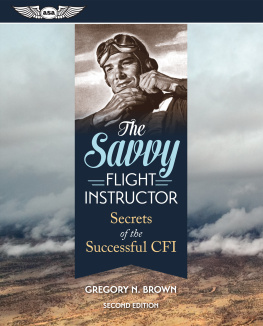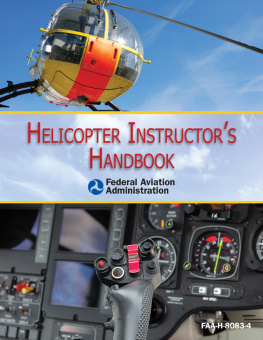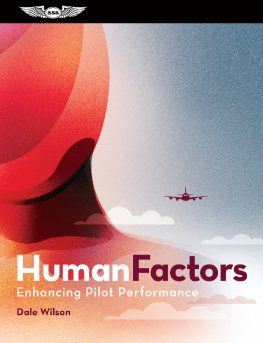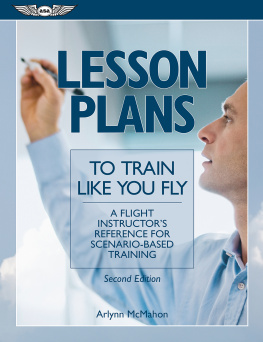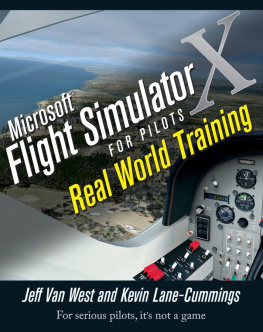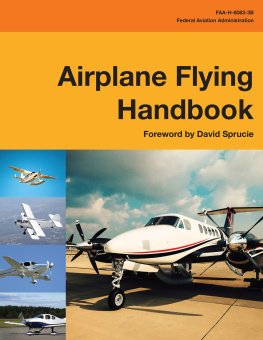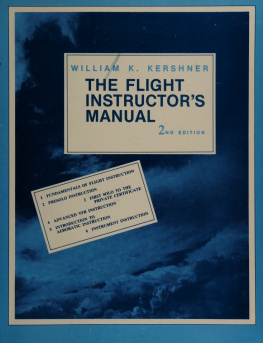Teaching Flight
by LeRoy Cook
Aviation Supplies & Academics, Inc.
7005 132nd Place SE
Newcastle, Washington 98059-3153
Visit the ASA website at www.asa2fly.com/reader/tchflt for the Reader Resources page containing additional information and updates relating to this book.
2019 Aviation Supplies & Academics, Inc.
All Rights Reserved. No part of this publication may be reproduced, stored in a retrieval system, or transmitted in any form or by any means, electronic, mechanical, photocopy, recording, or otherwise, without the prior written permission of the copyright holder. While every precaution has been taken in the preparation of this book, the publisher and LeRoy Cook assume no responsibility for damages resulting from the use of the information contained herein.
None of the material in this book supersedes any operational documents or procedures issued by the Federal Aviation Administration, aircraft and avionics manufacturers, flight schools, or the operators of aircraft.
ASA-TCHFLT-EB
ISBN 978-1-61954-850-3
Cover photo: LeRoy Cook
All photographs provided by the author and used with permission.
BIO
A lifelong student of aviation, LeRoy Cook is an experienced pilot and instructor whos been flying and teaching for more than 50 years. He holds ATP certification for single and multi-engine airplanes and commercial certification for gliders and seaplanes. His Gold Seal flight instructors certificate has ratings for single-engine and multi-engine airplanes, instrument (airplane), and glider. Cook is the author of over 1,700 magazine articles and has written or co-authored four aviation books, including Beyond Flight Training, Flying the Light Retractables, and Caravan: Cessnas Swiss Army Knife with Wings. He wrote the CFI column in Private Pilot magazine for 34 years and was the editor of Twin & Turbine magazine from 2012 to 2016.

FOREWORD
As a young boy, LeRoy Cook wandered onto an airfield with a dirt strip and taildragger airplanes. General aviation was blessed. LeRoy learned to fly. He got his private certificate, commercial, flight instructor, instrument and ATPas have so many others.
But, LeRoy was different.
He never stopped learning. LeRoy Cook, after 60 years of flying, plus or minus a year or two, is still learning. He is still exploring the magic of lift, the symmetry of balanced flight, the mystery of the perfect landing. It is a personal quest. But, he is happy to share that quest with those that share his love of flight.
But that is only part of the blessing. LeRoy Cook has written numerous articles and books about flying. They range from the techniques of piloting an airplane to the joys of being in the air. His writing is infused with a quiet, plain-spoken philosophy that encourages flyers to do their best in whatever it is that they fly.
LeRoys style of writing is lean. He never uses two words when one will do. The result is a short sentence packed with information. So, readers, pay attention. In this, his latest book, LeRoy is writing to new flight instructors. But it is must reading for any flight instructor or anyone that might aspire to become one. As a flight instructor and a Designated Pilot Examiner, I attest to the fact that the information in this book is sorely needed in the aviation community.
In this, the age of glass cockpits and the miracle of the magenta line, we are producing electronic data managers. As a result, stick and rudder skills have deteriorated. Our leading cause of accidents is classified as Loss of Control. Many of todays flight instructors were trained to be electronic data managers. It is no surprise that that is what they teach. Keeping the ball in the center is secondary or even tertiary to the colorful screens in the cockpit. Traffic advisories send them heads down in the cockpit searching for possible airborne conflicts, when their eyes and attention should be on the horizon.
LeRoy Cook does not disparage the advanced avionics that are part of aviation today. But he does emphasize the basics of flight and the eclectic craft of teaching those basics.
Read LeRoy Cooks book. If you are a flight instructor or aspire to become one, this book will be a trusted guide.
David Bradley
CFI and DPE

INTRODUCTION
An Introduction to Instructing
A few years ago, when I passed the mark of 10,000 hours of dual given, it was suggested that I write a book about learning to fly. I hesitated, because there have been many, many books written about flight training. What could I possibly add that has not been said before? However, I have had the advantage of a long perspective, passing from the age of dirt runways, tailwheel trainers, tube-type radios and minimal instrumentation, to the development of todays full range of advanced aircraft. Even in this day of cockpit displays and composite airframes, the sky does not change, only our means of participating in flight.
In the course of more than 50 years of flight instructing, I have taught only a few hundred people to fly. One might expect the total to run into thousands, but the reality of aviation is that we have to introduce numerous people to flying in order to make a single licensed pilot. I once analyzed the student record folders accumulated from a dozen years of instructing; of those sticking with the program long enough to make their first solo flight, only a third continued on to gain their private license.
What happened to the other two-out-of-three? The reasons, or I should say the excuses, varied widely, but most of them boiled down to loss of interest. In some cases, a relocation interrupted the students flying lessons; theres always the hope that those who left the local area eventually completed their training elsewhere. The fact remains, learning to fly is more work than some people want to deal with. Most who shared their feelings used the excuses of spousal impediment, poverty, lack of time and just plain fearfulness. It takes considerable effort, both in the air and with ground study, to complete the course, and we must not assume its for everybody.

Flying, unlike many other activities, cannot be evaluated from afar. There has to be an initial period of participation before a decision can be made about continuing to devote time and treasure to the training. Thus, a large dropout percentage is normal. Dilettantes need not apply. I try to explain the commitment required during the initial Q&A session, but there still has to be a few experimental hours flown to test the waters. I cant always judge who will last and who will wash out. I like students to say things like, this is great! and, I dont want to stop! But when the real work of building layers of piloting skill is undertaken, I know there will be hours that test resolve.
And so, we instructors have to be innovative to keep as many students as possible hungering for more. I cant teach them all, nor should I expect to. Personality conflicts aside, the sky is not for everyone, the responsibilities of a pilot-in-command are demanding, and if a person doesnt want to be there, they should not be coerced to continue. I dont often call up truant students to beg them to make an appointment. If they want to continue their lessons, they know where to find us. That said, everyone needs encouragement at various times, and we CFIs must not lose sight of our role in encouraging and facilitating.



